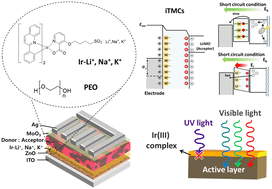Ionic Ir(iii) complex-interfacial layer for efficient carrier collection via induced electric dipole†
Abstract
The power conversion efficiency (PCE) of polymer solar cells (PSCs) has recently reached >19% through the development of photoactive materials, particularly non-fullerene acceptors. Interfacial layers (ILs) have been another essential factor in optimizing device charge extraction. In this study, we propose a series of ILs, in which ionic iridium(III) (Ir(III)) complexes of different alkali metal cations (Li+, Na+, and K+) enhance the charge collection efficiency between zinc oxide and active layers through an induced internal electric field. The anionic coordinate sphere and counter-cations of the Ir(III) complexes are distributed according to the operating voltage of the PSCs, causing electric dipoles that enhance the internal electric field and charge collection efficiency. Ion species migration in the ILs is confirmed using electrochemical impedance spectroscopy. The PCE of the PM6:Y6-based PSCs was improved from 14.0% to 15.6% by introducing an IL (Ir–K+). Furthermore, the stability of PSCs containing ionic Ir(III) complexes is enhanced significantly under ultraviolet (UV) light and AM 1.5 G one-sun irradiation owing to the intense UV absorption capacity and photo durability of the ILs. A device containing the Ir(III) complex-based ILs retained ∼60% of its initial PCE after UV irradiation, whereas the control device retained only ∼20%.



 Please wait while we load your content...
Please wait while we load your content...